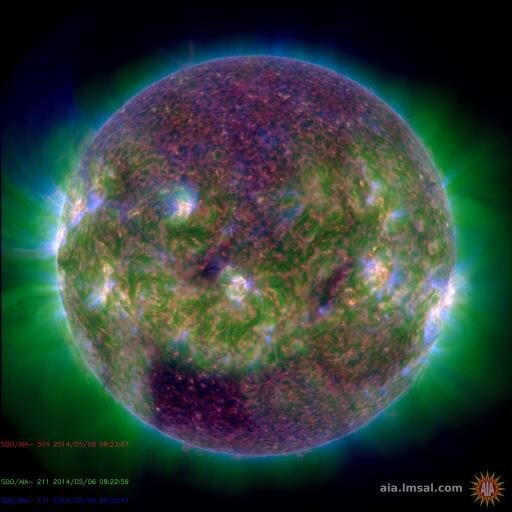
Keith Strong
@drkstrong
Followers
26K
Following
229
Media
8K
Statuses
10K
Solar physicist interested in Sun-Earth connections, climate change, and public outreach.
Joined November 2011
A Geomagnetic Storm: The high-speed solar wind from the coronal hole (see earlier tweets) eventually clipped the Earth producing a G2-level geomagnetic storm. Fortunately, most of the highest speed winds passed to our south.
2
16
62
1000 C flares since 1 January 2025! That is almost exactly the same number as in the same period in 2024 (1041). Is the cycle holding steady at near solar maximum values or is it all downhill from here on?
2
7
39
A Shrinking Coronal Hole: Left: the solar corona as it was one solar rotation ago; right the same coronal hole today. It seems to have shrunk significantly, particularly on its southern border. That does not mean that we won't get a geomagnetic storm as it moves further west.
5
28
130
THE QUIET SUN SHATTERED THE SUN TODAY 2025 05 14 https://t.co/WicvLazrNF via @YouTube
1
11
25
2ND X FLARE! We have been hit by a second X flare - even bigger than the last (an X2.7). It caused another radio blackout storm (R3) this time affecting most of Europe, Asia and Africa but centered on the Middle East. It was from a different sunspot region than the first one.
3
103
367
The X flare did produce an R3 radio interference storm (strong). It mainly affected the eastern coasts of the Americas and western Europe. It also increased the 10 MeV proton flux here at Earth but has not (yet) tripped the warming levels (but it is close to doing so!).
3
28
124
The X flare (see last tweet) obviously produced a big coronal mass ejection but the question is was the region too far west to produce a significant geomagnetic storm here on Earth?
2
58
222
An X FLARE Out of Nowhere! The Sun just produced an X1.2 flare. It came from a region AR4081 which has not produce any flares until now. The last X flare was 6 weeks ago. Unfortunately, AR4081 is just about to go over the west limb just as it starts to become active! :(
1
31
146
Another large sunspot appearing over the East limb of the Sun. This is probably the remnant of sunspot region 4078.
3
26
132
A weak (G1) geomagnetic storm is in progress, it my strengthen in the next few hours. Solar wind speed rose to about 450 km/s. Should be some good aurora at high latitudes.
1
13
64
9000 C FLARES! Solar Cycle 25 just reached another milestone - a total of 9000 C flares since the cycle began in January 2020. That out paces the entire count for SC24 (7811) of Solar Cycle 24 by 18%. It is nearly twice as many as SC24 had at the same stage after solar minimum)
3
25
95
The Sun produced a series of mid-level C flares. I thought it was from the large sunspot region (4079). But no, it was from this tiny region in the SE that is growing rapidly over the last day. It that continues, I would not be surprised if it soon produces an M flare of larger.
3
10
68
Still going! The weak geomagnetic storm that I have tweeted about for the last couple of days is grumbling along for nearly 2 days at a low level. It never intensified but equally seems to refuse to die.
2
20
74
A low-level (G1 - yellow)) Geomagnetic storm persists for nearly a day. No sign of it intensifying so far. Still some nice aurora likely at high latitudes tonight.
0
7
18
SOLAR CYCLE 25 UPDATE FOR APRIL 2025 https://t.co/iGxKv9hBXT via @YouTube
0
3
12
Geomagnetic Storm in Progress. At the moment it is only a G1 (weak) storm, but it may yet intensify. Look for some nice aurora at high latitudes.
0
12
31
The latest smoothed sunspot number from the SIDC reached a new high for this cycle at ~161. This means that SC25 will peak no earlier than October 2024 and have a maximum of >161. A big disappointment for the advocates of a Grand Solar Minimum who forecasted a maximum of <100.
21
25
103
Huge sunspot group coming over the East Limb: Judging by its latitude it is likely the return of Active Region 4055. We will need to wait a day or two to see its magnetic structure and if it will produce any big flares. At 05:10 UT today, it produced an M1 flare. Promising!
3
35
172
PARTIAL ECLIPSE OF THE SUN SEEN FROM SPACE. The Solar Dynamics Observatory orbits the Earth at ~20,000 km altitude (a Sun synchronous orbit) so it gets to see eclipses differently and more often than Earth. Here the Moon clips the northern part of the Sun - happening right now!
4
58
160
